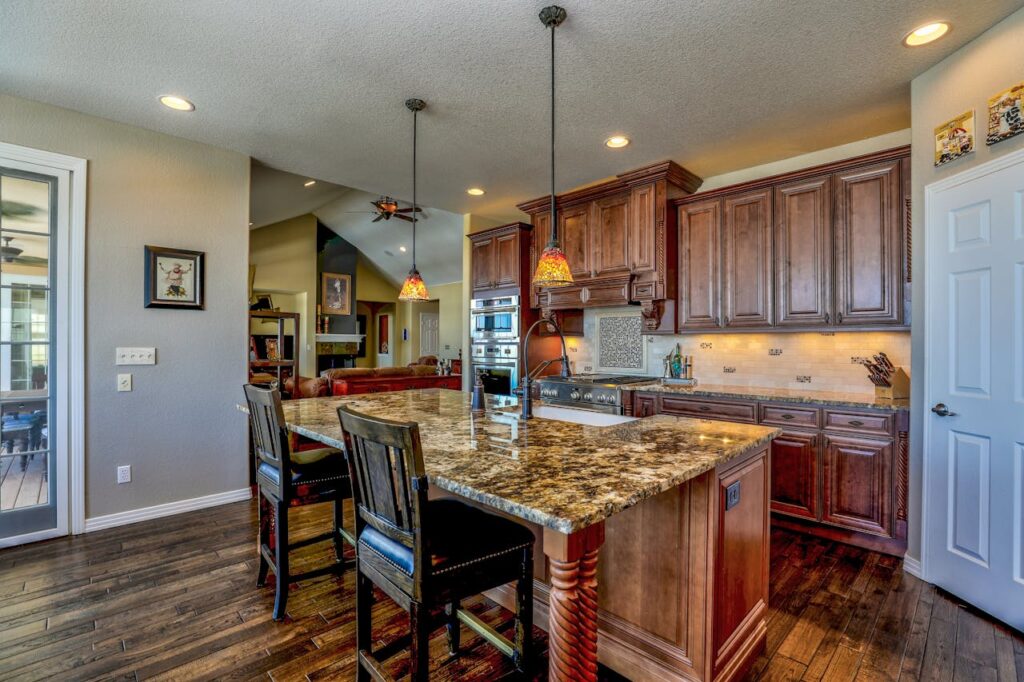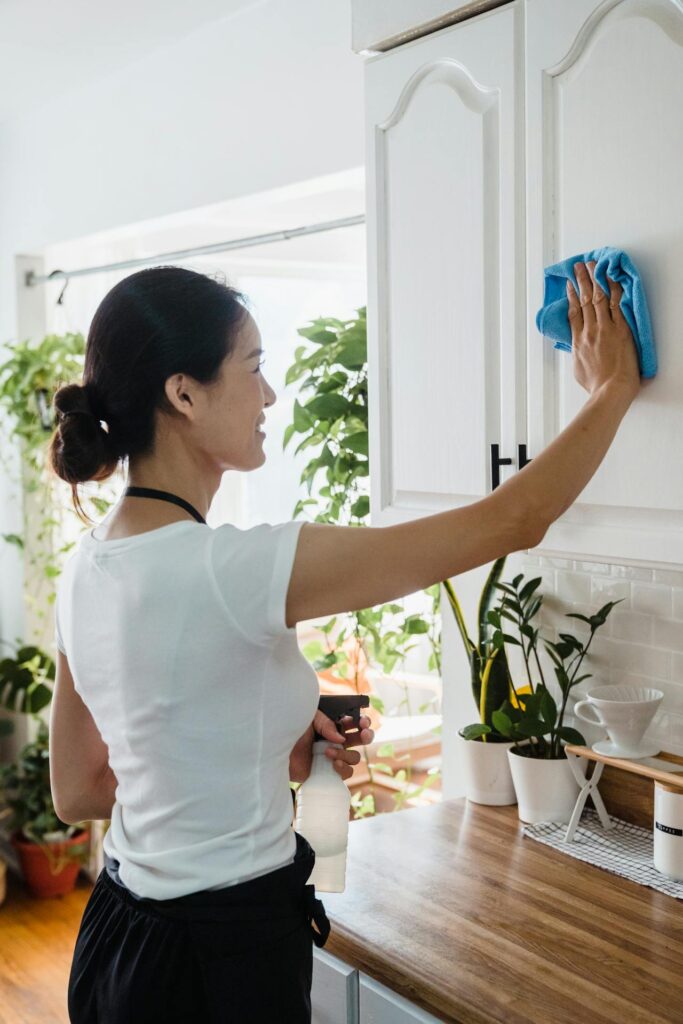Cleaning painted kitchen cabinets and maintaining their pristine appearance can be challenging, but with the right techniques and products, you can keep them looking brand new.
Whether you’re tackling years of grease and grime or just looking to maintain the glamorous look of your cabinets, we’ve got you covered.
In this ultimate guide, we’ll reveal all the tips you need to clean them. In short, from daily maintenance to deep cleaning, we’ve got you covered.
Stay with us and get ready to transform your kitchen.
Importance of Clean Painted Kitchen Cabinets

Any kitchen is made more elegant and stylish by adding painted kitchen cabinets. However, keeping them clean and free from stains is essential to maintaining their beauty and longevity.
Therefore, regular cleaning of painted kitchen cabinets prevents the build-up of dirt, grease, and grime.
And isn’t that what you want?
Because the above build-up can damage the paint and underlying wood.
In addition, cleaning the cabinets helps in maintaining a hygienic kitchen environment.
Tools and Materials Needed
So let’s get down to business. For your convenience, the following is a full list of tools:
- Soft microfiber cloths
- Mild dish soap
- Warm water
- White vinegar
- Baking soda
- Non-abrasive sponge
- Soft-bristle brush
- Cleaning spray (non-toxic)
- Cabinet polish (optional)
Daily Maintenance Tips
When you have the above tools handy, you are good to go.
To begin with, keep your cabinets looking fresh by wiping them down daily with a soft microfiber cloth. This helps remove dust and prevents grease from settling.
Quick Daily Cleaning Steps
- Step 1: Wet the microfiber cloth with warm water. (The warm water specifically removes dirt and oily surfaces that often form on the kitchen cabinets).
- Step 2: Then, gently wipe the cabinet surfaces.
- Step 3: Dry with a clean cloth to avoid water spots that can form patches later.
Weekly Cleaning Routine
After the quick daily cleaning, set up a day of the week (preferably a weekend) when you are less busy for a thorough cleaning exercise.
This is essential to remove any built-up dirt.
To begin with, remove all items in the cabinet to get easier access to all corners. Afterward, we recommend you follow these steps:
Weekly Cleaning Steps
- Step 1: Firstly, add small amounts of dish soap to some warm water.
- Step 2: Dip a non-abrasive sponge into the soapy water and wring out excess liquid.
- Step 3: Wipe down the cabinets, focusing on areas around handles and edges.
- Step 4: Rinse with a damp cloth to remove soap residue.
- Step 5: Dry with a soft cloth to prevent water damage.
- Step 6: Lastly, return your items to the now-clean cabinets
Deep Cleaning Techniques
For best results, deep cleaning should be done monthly or whenever you notice stubborn grime.
Deep Cleaning Steps
By the same token as the weekly procedure above, first remove all items in the cabinets. Then:
- Step 1: Create a cleaning solution with one part white vinegar and two parts warm water. The parts are equivalent to a cup.
- Step 2: Dip a soft-bristle brush into the solution.
- Step 3: Gently scrub the cabinet surfaces, paying attention to grooves and corners.
- Step 4: Wipe with a damp cloth and dry immediately.
- Step 5: Keep doing it until all cabinets are clean. Then return your items.
Removing Stubborn Stains
Despite all the cleaning, the odds are that there will be surfaces with stubborn stains.
Such stains require more effort but can be managed with the right approach. Here’s how you solve this:
Stain Removal Steps
- Step 1: Make a paste by combining baking soda, mild soap, and a few drops of water.
- Step 2: On the stained area, apply the paste.
- Step 3: Give it some time to settle.
- Step 4: Gently scrub with a soft cloth and rinse with water.
And boom! The stubborn stain is gone.

Handling Grease Build-Up
But wait! There’s more…
Grease.
The build-up of grease in kitchen cabinets, especially those near the stove, is an eye sore.
But, no worries. The removal is easy.
Grease Removal Steps
- Step 1: Use degreasing agents e.g. borax, lemon juice, cornstarch, or a mixture of vinegar and water.
- Step 2: Apply to the greasy area and let it sit for a few minutes.
- Step 3: Wipe clean with a damp cloth and dry.
It’s that simple.
Dealing with Water Damage
Surprisingly, water which is in constant use in the kitchen, can cause paint to peel or wood to warp if not addressed promptly.
So, how do you tackle this necessary culprit?
Water Damage Repair Steps
- Step 1: Dry the affected area immediately with a cloth.
- Step 2: Use a fan or dehumidifier to remove excess moisture.
- Step 3: If the paint is peeling, lightly sand the area and touch it with matching paint.
- Deal with any future water spillages instantly by drying them up. Letting them stay will allow them to sip inside the paint.
Maintaining the Paint Finish
Keeping the paint finish looking vibrant is your next goal. Steer clear of strong chemicals and abrasive kitchen tools. These may corrode the paint.
Paint Maintenance Tips
- Tip 1: Use a gentle cleaning solution. In general, we recommend:
i) Mild dish soap
ii) White vinegar
iii) Baking soda
iv) Non-toxic cleaning sprays
- Tip 2: Regularly dust and wipe down cabinets.
- Tip 3: Apply a cabinet polish occasionally for extra shine.
Common Mistakes to Avoid
Now that you have the tips, let’s quickly look at mistakes you must avoid to keep your cabinets in top shape.
Mistakes to Avoid:
- Using abrasive sponges or cloths. Eventually, they will have a detrimental effect on the cabinets’ quality.
- Applying too much water that leaves surfaces damp. These at length become mold.
- Ignoring small stains and spills. You must address them instantly.
FAQs
What’s the recommended cleaning frequency for painted kitchen cabinets?
We recommend daily light cleaning and weekly thorough cleaning
Can I use bleach on painted cabinets?
Bleach does not work well on wood or paint.
How should I proceed if the paint begins to peel?
After a quick sanding, touch it up with matching paint.
Are there any natural cleaning solutions for cabinets?
Yes, both vinegar and water or baking soda paste are effective natural cleaners.
How do I prevent grease build-up on cabinets?
To minimize grease buildup, wipe down cabinets regularly, especially after cooking.
Takeaway
In summary, keeping your painted kitchen cabinets clean and well-maintained is essential for preserving their beauty and functionality.
Consequently, with the right tools, products, and techniques, you can ensure that your cabinets remain pristine for years.
Remember to perform regular cleaning, tackle stains promptly, and avoid harsh chemicals to maintain the integrity of the paint finish.
Happy cleaning!
Do you need a hand in cleaning your painted kitchen cabinets? Call us today.
[…] smooth finish and durability, it requires more care when cleaning. They are best used in hallways, cabinets, and generally high-traffic […]